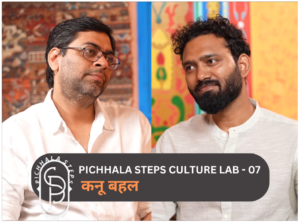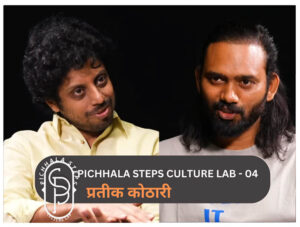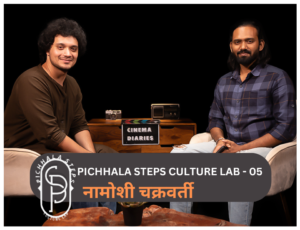Moderator (Satish): Welcome to The Cinema Diary. Today, we have a special guest, Kabeer Khurana, an acclaimed filmmaker known for his unique storytelling and creative vision. Welcome, Kabeer.
Kabeer Khurana: Thank you for having me, Satish. It’s a pleasure to be here.
Satish: Kabeer, you recently mentioned that you travelled to France for a trip to Europe. Was it for a film festival?
Kabeer: Yes, I went to attend the Annecy Film Festival, which is the world’s largest animation festival, often referred to as the Oscars of Animation. It was an incredible experience to see so many artistic and abstract films that are quite different from the typical Disney or DreamWorks animations.
Satish: That sounds fascinating. Before we dive into your films and creative process, could you share a bit about your background? How did you start exploring cinema? Was it something that ran in the family?
Kabeer: Definitely. My grandfather was a pioneer of Indian animation. He started his journey in Lucknow, studied Indian classical music and fine arts, and then moved to Mumbai to join the film division as a background artist. He worked with many prominent filmmakers in the 70s and made several notable animation films. My father followed a similar path, starting in advertising as an animator and eventually moving into live-action filmmaking.
Satish: It seems like you had a rich cinematic heritage. When you were around 15 or 16, did you ever feel that your interests might lie elsewhere, apart from animation and filmmaking?
Kabeer: Yes, for a brief period, I wanted to become an architect because it combined art and science. Although I ultimately returned to filmmaking, the creative and design-focused aspects of architecture have greatly influenced my storytelling approach.
Satish: That’s interesting. You mentioned earlier that Syed Akhtar Mirza was your mentor. Can you share more about his influence on you and something unique about him that people might not know?
Kabeer: Syed Akhtar Mirza had a profound impact on me. He always emphasized the importance of personal stories and cinema of integrity. One of his philosophies was that while technical skills can be learned, a storyteller must always keep a bottle of whisky in one pocket and their childhood in the other. This was his way of saying that personal experiences and a touch of creativity are essential for storytelling.
Satish: That is a beautiful philosophy. How do you blend these teachings with your own style of filmmaking?
Kabeer: I try to balance my grandfather’s spiritual and observational approach with Syed uncle’s politically charged and participatory style. My films often explore both social and spiritual themes, striving to be both a mirror and a weapon in addressing societal issues.
Satish: Speaking of your films, let’s talk about Religion for Dummies*. What is the premise of this film, and why did you choose to make a film on this theme?
Kabeer: Religion for Dummies is not just about religion but critiques how Godmen commercialize and distort religious truths for personal gain. The film was inspired by a 1974 film by Pramod Pati called Abid. It uses a mockumentary style to highlight societal hypocrisies and double standards.
Satish: Another notable film of yours is Chutta Baji, which you made during the lockdown. Can you tell us about its premise?
Kabeer: Chutta Baji captures the dynamics of a small family during the lockdown, focusing on their interpersonal conflicts and evolving relationships. It explores the generational gap and the changing aspirations within a family.
Satish: The generational gap is a theme that resonates with many. How personal was this story for you?
Kabeer: Very personal. While my parents are artists and quite progressive, there are still some generational differences that we navigate. This film dramatizes those differences and conflicts that are universal to many families.
Satish: You have a unique approach to filmmaking. Who are some of the filmmakers, both Indian and international, that inspire you?
Kabeer: Internationally, I admire Quentin Tarantino for his visionary approach. In Indian cinema, Rishikesh Mukherjee and Basu Chatterjee have been major influences. Among contemporary filmmakers, I look up to Vikramaditya Motwane and have had the opportunity to work with Siddharth Diwan, whose cinematography is revolutionary.
Satish: Your film Salvador is quite different from your other works, blending painting, dance, and storytelling in a musical format. Can you tell us about its premise and your inspiration?
Kabeer: Salvador is inspired by the Spanish surrealist painter Salvador Dali and his muse, Gala. The film explores their tumultuous relationship and how Gala’s presence influenced Dali’s creativity. We used colors extensively to reflect the changing moods and emotions throughout the film, creating a visually engaging narrative.
Satish: The use of color psychology in your films is remarkable. How do you decide on a color palette for your films?
Kabeer: We usually set a color palette based on the emotions we want to convey. Colors like red and green can symbolize different things, such as romance or envy. By consistently associating certain colors with specific emotions, we create a visual language that enhances the storytelling.
Satish: Kabeer, it’s been a pleasure talking to you and gaining insights into your creative process and storytelling. Thank you for sharing your journey with us.
Kabeer: Thank you, Satish. It’s been great discussing my work and experiences.




